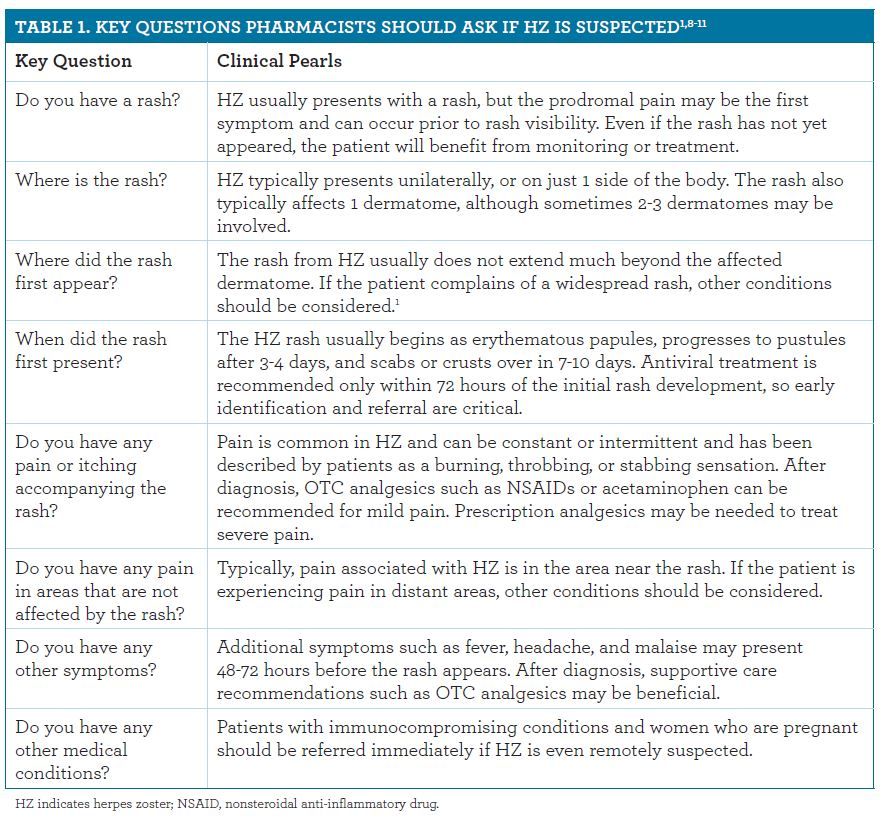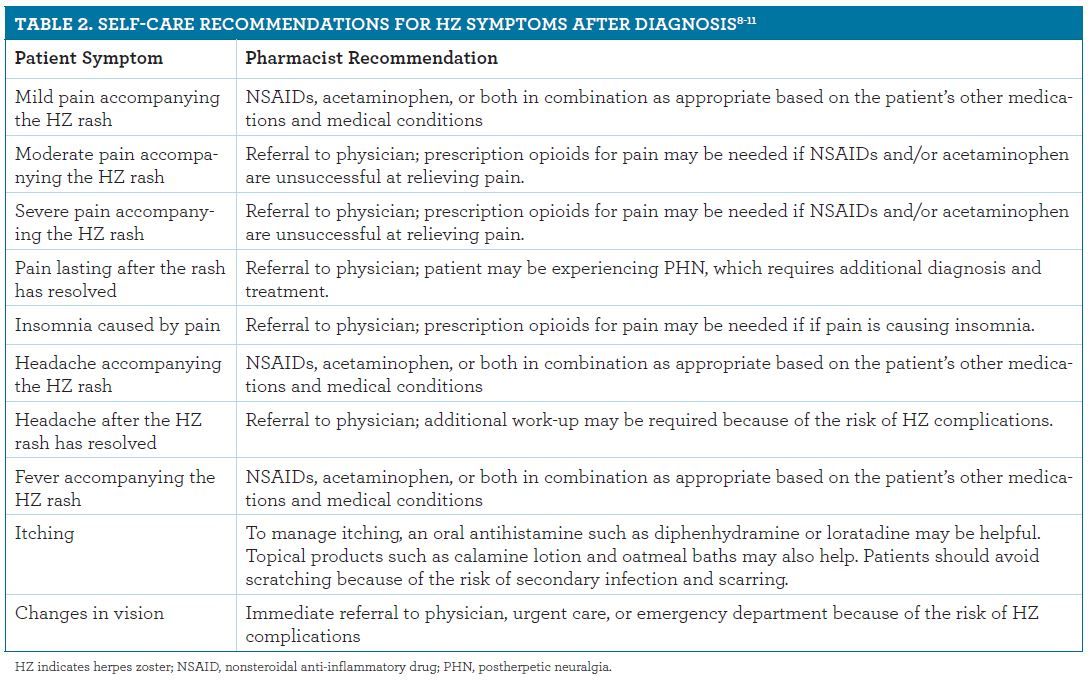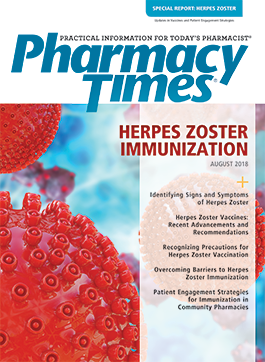Publication
Article
Supplements
A Pharmacist's Guide to Identifying the Signs and Symptoms of Herpes Zoster
Author(s):
Herpes zoster, also known as zoster or shingles, is caused by the reactivation of the varicella zoster virus. After an individual has been exposed to the varicella virus through chickenpox or via vaccination, the virus remains dormant in the dorsal root ganglia.
Herpes zoster (HZ), also known as zoster or shingles, is caused by the reactivation of the varicella zoster virus. After an individual has been exposed to the varicella virus through chickenpox or via vaccination, the virus remains dormant in the dorsal root ganglia.1 According to the CDC, 1 million cases of HZ occur in the United States per year and 1 of every 3 people will have HZ at some point during their lifetime.2 The likelihood of contracting HZ is higher in certain patient populations, especially those with an immunosuppressive medical condition such as leukemia, lymphoma, or HIV and those who take immunosuppressive medications like corticosteroids and antirejection medications after organ transplantation.2 One study estimates that HZ is the underlying cause of death of 78 people in the United States annually.3
The risk of contracting HZ increases with age. Those over 50 years are at a higher risk of having HZ with more severe, long-term complications.4 Postherpetic neuralgia (PHN) is the most common complication of HZ, causing persistent pain in the lesion-affected area, and can last years after the HZ rash has resolved. Among those 60 years and older, 13% will develop PHN after contracting HZ.1 Other complications include ophthalmic involvement, which can cause permanent vision loss, bacterial infection due to increased susceptibility in the zoster lesions, and palsies resulting from involvement of cranial and peripheral nerves.1 Complications in other organ systems affected by HZ can include hepatitis, pneumonitis, meningoencephalitis, and acute retinal necrosis.1
Presentation and Early Detection
Community pharmacists have the opportunity to play a key role in the early detection and treatment of HZ. Pharmacists are one of the most trusted and accessible health care providers, with the majority of the United States population living within 5 miles of a community pharmacy.5-7 By knowing the signs and symptoms of HZ, pharmacists can help their patients identify HZ and seek immediate treatment. Early identification is critical, as antiviral therapy can be initiated for patients who are treated within 72 hours of the onset of symptoms. Antiviral therapy can lessen the severity and duration of the pain, prevent formation of new lesions, promote rapid healing of existing lesions, and reduce the spread of HZ to others.8,9 However, if the patient has had symptoms for over 72 hours, the benefit of antivirals is less clear and they are often not prescribed. By helping triage patients and referring them to seek immediate care, pharmacists can help reduce the severity of the disease and the likelihood of its spreading to others. See Table 1 for a list of questions that may be helpful if HZ is suspected.1,8-11

Often laboratory testing is not needed because the signs and symptoms of HZ are distinct enough to make an accurate clinical diagnosis once the rash has appeared. A unique feature is the location of the rash. HZ usually affects 1 dermatome, although it can occasionally affect multiple ones.8 The thoracic and lumbar dermatomes are the ones most commonly effected. Serious complications can occur when the dermatomes of the face are affected. This can include vision loss and cranial palsies.12 The initial HZ rash usually presents as an erythematous rash of small raised papules. After 3 to 4 days, the papules progress to pustules or blisters, and after 10 days, the lesions typically crust or scab over and no longer considered infectious.8
In addition to rash, pain is the most common symptom of HZ. Prodromal pain, or pain that occurs before the rash begins, is reported by approximately 75% of patients and may occur in the days to weeks before the rash is visible.8 The pain can be constant or intermittent with touch and has been described as a burning, throbbing, or stabbing sensation.8 Mild cases can be treated with nonsteroidal anti-inflammatory drugs (NSAIDs), acetaminophen, or both in combination. Moderate to severe pain may require treatment with opioid pain relievers. Other, less common symptoms of HZ include headache, fatigue, fever, and malaise. These symptoms are seen in less than 20% of patients.8 Patients with these symptoms can benefit from an OTC NSAID or acetaminophen.
Pharmacists: Detectors and Immunizers
As an integral part of the clinical team, pharmacists can counsel patients with a confirmed diagnosis about OTC and prescription medications for the treatment of HZ, the progression of the disease, and self-monitoring for complications. See Table 2 for a list of recommended self-care options for HZ.8-11 Note that these recommendations should be made after the diagnosis is confirmed, not in place of a referral for medical attention, to ensure that the standard of care is followed.

Another emerging role for pharmacists is identification and treatment of shingles in the community pharmacy setting. Some state practice acts allow pharmacists to prescribe treatment for ailments like herpes zoster through collaborative drug therapy agreements (CDTAs) or collaborative practice agreements. Pharmacists collaborate with physicians to prescribe medication as allowed in an agreed-on protocol. For HZ, these protocols often include treatment of only uncomplicated shingles cases, requiring referral for any cases in which the rash has become more severe with further complications.8,13 In cases meeting CDTA treatment criteria, the pharmacist is authorized to prescribe valacyclovir, famciclovir, or acyclovir, ensuring the patient has quick access to initiating antiviral therapy.
Patient monitoring is critical after an episode of HZ because 10% to 15% of patients will develop PHN. Risk factors for PHN include older age, greater rash severity, and severe acute pain.14 Pharmacists can aid in patient monitoring by following up with the patient to confirm that no new lesions are forming, old lesions are crusting or scabbing, pain is stable or resolving, and other symptoms have resolved or are relieved by the recommended treatment. If new lesions are forming, a new fever has developed, or pain is becoming more severe, the patient should be referred for immediate treatment.
Whether triaging and referring the patient for treatment, prescribing antivirals per CDTA protocol, counseling on newly prescribed medication, recommending OTC self-care options, or aiding the patient in self-monitoring the progression of shingles, pharmacists can play a key role in the care of patients with HZ.
KIMBERLY MCKEIRNAN, PHARMD, BCACP, is a clinical assistant professor in the department of pharmacotherapy at the Washington State University College of Pharmacy and Pharmaceutical Sciences.
References
- Shingles (herpes zoster) clinical overview. CDC website. cdc.gov/shingles/hcp/clinical-overview.html. Updated February 21, 2018. Accessed July 14, 2018.
- Shingles (herpes zoster) overview. CDC website. cdc.gov/shingles/about/overview.html. Updated June 15, 2018. Accessed July 14, 2018.
- Mahamud A, Marin M, Nickell SP, Shoemaker T, Zhang JX, Bialek SR. Herpes zoster-related deaths in the United States: validity of death certificates and mortality rates, 1979-2007. Clin Infect Dis. 2012;55(7):960-966. doi: 10.1093/cid/cis575.
- Harpaz R, Ortega-Sanchez IR, Seward JF. Prevention of herpes zoster. Recommendations of the Advisory Committee on Immunization Practices (ACIP). MMWR Recomm Rep. 2008;57(RR-5):1-30; quiz CE2-4.
- Knapp KK, Paavola FG, Maine LL, Sorofman B, Politzer RM. Availability of primary care providers and pharmacists in the United States. J Am Pharm Assoc (Wash). 1999;39(2):127-135.
- Honesty/ethics in professions. Gallup website. gallup.com/poll/1654/honesty-ethics-professions.aspx. Accessed January 9, 2017.
- DeArment A. Pharmacists are face of health care in community. RxImpact. nacds.org/pdfs/pr/2012/rximpact-0312.pdf. Published March 2012. Updated July 27, 2016.
- Dworkin RH, Johnson RW, Breuer J, et al. Recommendations for the management of herpes zoster. Clin Infect Dis. 2007;44(suppl 1):S1.
- Gnann JW Jr, Whitley RJ. Clinical practice. Herpes zoster. N Engl J Med. 2002;347(5):340. doi: 10.1056/NEJMcp013211.
- Kost RG, Straus SE. Postherpetic neuralgia--pathogenesis, treatment, and prevention. N Engl J Med. 1996;335(1):32-42.
- Straus SE, Ostrove JM, InchauspéG, et al. NIH conference. Varicella-zoster virus infections. Biology, natural history, treatment, and prevention. Ann Intern Med. 1988;108(2):221-237.
- Shaikh S, Tah CN. Evaluation and management of herpes zoster ophthalmicus. American Family Physician website. https://www.aafp.org/afp/2002/1101/p1723.html. Published November 2002.
- Clinical community pharmacist. Washington State Pharmacy Association website. wsparx.site-ym.com/?CCP. Accessed May 23, 2016.
- Jung BF, Johnson RW, Griffin DR, Dworkin RH. Risk factors for postherpetic neuralgia in patients with herpes zoster. Neurology. 2004;62(9):1545.







